World’s Strongest Laser Unveiled at California Lab
 |
The world’s most powerful laser, created to help keep tabs on the nation’s nuclear weapons stockpile while also studying the depths of space, has been unveiled in California. The super laser, known officially as the National Ignition Facility, was unveiled May 29 at the Lawrence Livermore National Laboratory about 50 miles east of San Francisco.
The NIF, which is the size of a football field, consists of 192 separate laser beams, each traveling 1,000 feet in one-thousandth of a second to converge simultaneously on a target the size of a pencil eraser. Such a high concentration of energy can generate unprecedented temperatures and pressures in the target materials — temperatures of more than 100 million degrees and pressures more than 100 billion times Earth’s atmosphere. These conditions are similar to those in the stars and the cores of giant planets.
Because the NIF allows scientists to mimic conditions inside planets and new solar systems, the lab’s officials said they would be able to conduct experiments that could never have previously be undertaken on Earth. The laser also will be used in non-ignition experiments to show how different materials react in extreme situations. Because the intensity of the beam is similar to the intense energy output of a nuclear detonation, the NIF also will be used to gather information about nuclear reactions. Federal officials said they plan to use the NIF to ensure aging nuclear weapons are functioning properly without resorting to underground testing.
According to the Lawrence Livermore National Laboratory, which is overseeing the NIF, the NIF’s three missions are:
• to provide a better understanding of the complex physics of nuclear weapons;
• to explore basic science, such as astrophysical phenomena, materials science and nuclear science;
• and to provide scientists with the physics understanding necessary to create fusion ignition and energy gain for future energy production.
In March, NIF became the first fusion laser in the world to break the megajoule barrier (a megajoule is the energy consumed by 10,000 100-watt light bulbs in one second) by delivering 1.1 million joules of ultraviolet energy to the center of its target chamber — more than 25 times more energy than the previous record-holder. “More energy will be produced by this ignition process than the amount of laser energy required to start it. This is the long-sought goal of energy gain that has been the goal of fusion researchers for more than half a century,” said NIF director Edward Moses.
Every NIF experimental shot requires the coordination of up to 60,000 control points for electronic, high voltage, optical and mechanical devices, which involves motorized mirrors and lenses, energy and power sensors, video cameras, laser amplifiers and diagnostic instruments. Achieving this level of precision requires a large-scale HPC control system as sophisticated as any in government service or private industry. The meticulous orchestration of these parts results in the propagation of 192 separate nanosecond (billionth of a second)-long bursts of light over a one-kilometer path length. The 192 separate beams must have optical pathlengths within nine millimeters so that the pulses can arrive within 30 picoseconds of each other at the center of the target chamber. Then they must strike within 50 micrometers of their assigned spot on a target mere millimeters wide.
NIF’s pointing accuracy can be compared to standing on the pitcher’s mound at AT&T Park in San Francisco and throwing a strike at Dodger Stadium in Los Angeles, some 350 miles away. Because the precise alignment of NIF’s laser beams is extremely important for successful operation, the requirements for vibrational, thermal and seismic stability are unusually demanding. Critical beampath component enclosures (generally for mirrors and lenses), many weighing tens of tons, were located to a precision of 100 microns using a rigorous engineering process for design validation and as-installed verification.
Copyright © 2009 The Associated Press and the Lawrence Livermore National Laboratory. All rights reserved.




